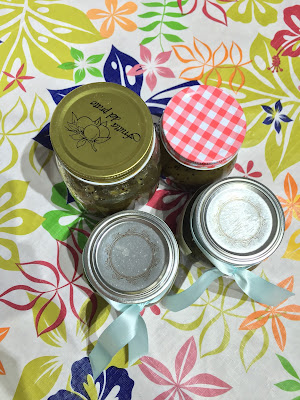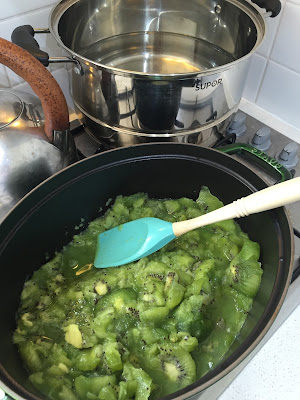Kiwi Jam

The first post of talking about making jam doesn't seem to fit this blog as I claim myself as a home baker. But thanks to my Queen-Victoria-Market-lover boyfriend, who one day carried back a whole box of discounted kiwis (literally 70 in total!), here I figure out this jam-making way to preserve these green beauties longer. Since I love the science behind any baking/cooking processes, which on the one hand makes me feel like a Dr. in the kitchen, on the other hand mastering the scientific principle is really the foundation of lowering the failure rate and creating innovative recipes. So, let's dig in some serious facts before introducing the recipe.
Pectin
Pectin is carbohydrate polymer (a long and linked chains of sugar molecules) found in fruits, which is one key role of forming the jelly-like consistency. It is soluble, that is why when we cook fruits, they gradually become softened. When being boiled, cell walls are destroyed, so the pectin is released. Then with the sugar added in, the pectin-water equilibrium breaks down, the pectin precipitates out by binding to each other in the long chain. Thereby, we have a fibrous network that allows a gel to form. However, because the pectin is a negatively charged colloid, the negative+negative fibre network is not stable at this stage. Until we add in any acidic juices, which are positively charged. Hence, with the positive+negative combination, we finally establish a stably three-dimensional gel network!
Pectin is abundant in the peel of citrus fruits, that's why there are certain proportion of skins in the marmalade jam. Also, commercial pectin is obtained from those citrus' peels. High-pectin fruits include those sour and under-ripe (tart apples, citrus fruit, sour blackberry, cranberry, currants,plum...), conversely, sweet and over-ripe fruits have less pectin (strawberry, cherry, blueberry, peach, pineapple, kiwi, apricot...). It makes sense because ripe fruits are normally very soft and dried due to a low level of pectin.
Sugar
In addition to enhancing the pectin's gel-forming capability by drawing water to itself, promoting the pectin to stick with each other. Sugar also acts as a natural preservative. How? Bacteria loves moist environments where they can reproduce quickly. Unluckily sugar absorbs water easily and strongly. Thereby, by soaking up the available water in food, sugar prevents the regrowth of microorganism that can spoil food. For store-bought jams, 1:1 ratio of fruit to sugar is at least. For my kiwi jam, I only add in 45% sugar of the weight of kiwi flesh. It is not as thickened as supermarket ones, but once set it in the fridge for a while, I suppose the texture is perfect for the toast and scone! More importantly, the home-made jam is full of natural fruitiness, with less health concerns (to be honest, still consuming half sugar in each teaspoon).
Acid
As mentioned, acids are critical in helping the pectin set as these acidic pHs (2.8-3.3) can lower the repulsive forces between the COOH groups in the pectin.
Setting point
When should the boiled fruit-sugar mixture done? If you have a probe thermometer (so handy, get one) like me. Things will be easier. Your jam will be ready to pack in 103˚C-104˚C, so called the setting point. We all know that the boiling point of water is 100˚C. While we heat the mixture, the more water is evaporated, the more concentrated the sugar will be. And the boiling point of sugar is above 100˚C. So, 103˚C-104˚C means there is little water left , and the gel network should have established.If you don't have the probe thermometer. Freeze a plate ahead, when bubbles are seen less than the beginning condition, scoop out a little jam and put on your iced plate. If the jam is running very slowly on the upright plate, then it is all good. If it runs very quickly, there is still enough water, just continue boiling, then test in every 3 minutes. If it stays there without moving at all, why you heat it so long?!
Alright, the dry stuff is finally over. Let's move to the ingredients.
Ingredients
Kiwi flesh: 1434 g
Sugar: 645g (45%)
Lime: 1 middle size
Bottles: three 300ml+ one 550ml (two thirds full)
Method
 |
| 1. Peel all kiwis (I halved them and scooped out the flesh), make sure you scale the tub beforehand then you will know how much of your fruits by the end. |
 |
| 2. Transfer the fruits into a big enough sauce pot on a medium-high heat. Pour your sugar and squeeze lime juice gradually. |
 |
| 3. Once the mixture start to boil, lower the heat to small. Skim the foam out as they are actually air bubbles that will spoil the jam after canning. |
 |
| 4. Meanwhile, sterilise the glass bottles and lids in the boiling water for 10 minutes. |
 |
| 5. Dry them afterwards on a rack. |
 |
| 7. Fill each warm glass bottle with hot jam until 1cm empty up to the lid. Don't tight the lid to the end, stop when you are about to feel the resistance. Move all cans back to pot that you process the sterilisation just now. Refill more water if necessary to cover all bottles with 1cm depth above. Keep heating 15 minutes after the water complete boil (The reason for this step is to kill all the remaining bacterias outside the bottles, especially those hanging around the bottle neck area). 8. The final step is really important to mention! After taking out all canned jams, listen carefully there should be a "Peng" sound for each bottle (takes about 5-10 minutes), and meanwhile the centre area of lids should be sank. It is because when heated bottles go back to the room temperature, the inside-1cm-empty-air that we reserved in the step 7 is contracted due to the coldness, hence the lid is stuck very tightly and we finally create this vacuum and sterile environment for our jams!
9. The jam is so fruity and comfortably sweet. It should thicken up once setting in the fridge. It can be reserved in the room temperature for one month and approximately one year in the fridge after opening, thanks to all our hard work put before to make sure they are germ-free now. (go soooo well with my sourdough!)
10. Pack them and share with our family and friends!
|
Finally, I really need to clarify this long-storytelling-without-knowing-where-is-the-end will not be my blog style...! Just happen to choose topic where so many scientific details should be conveyed. Will definitely pick up a relaxing recipe next time :)
References
-JAMS AND PRESERVES | Methods of Manufacture, D.A. Smith
-THE SCIENCE OF JAM AND JELLY MAKING, University of Kentucky, College of Agriculture
-Ball Blue Book® of Preserving, Altrista
Consumer Products Company, 2003.
-McGee, H. On Food & Cooking, Scribner,
1997.
-USDA
-What Makes Jam Set? – The Chemistry of Jam-Making




Comments
Post a Comment